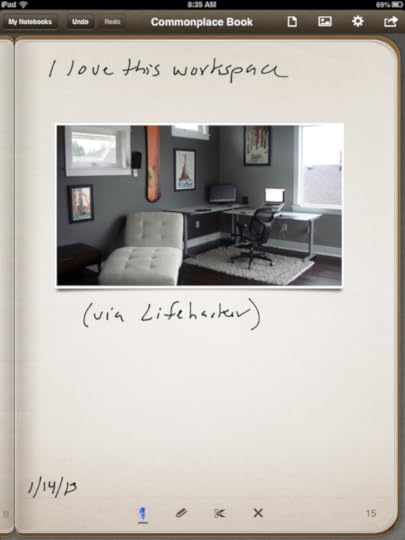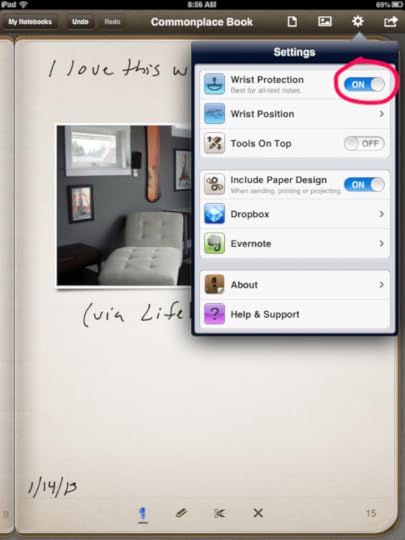Going Paperless: How Penultimate and Evernote Have Replaced My Pocket Notebook
When I went paperless–now going on more than two years ago–I tried to go pretty much wholesale. There were the occasional pieces of paper I had to handle, but mostly I tried to do everything that I used to do on paper in digital form. The trickiest thing for me, back then, was converting my pocket notebook to digital format. So tricky was it, that I stubbornly gave up the notebook entirely, rather than having to still use paper. Recently, however, I’ve found ways to recreate that notebook without paper and it has been a lifesaver! Let me explain.
Just about every writer I know these days carries around a Moleskine notebook to jot down thoughts or ideas. At a science fiction convention panel audiences seem roughly split between those with tablets and those with Moleskine notebooks. Until I few years ago, I, too, used a Moleskine notebook to jot down whatever happened to occur to me on a given moment. I still have that notebook. Here it is:
The more I went to conventions and hung around these other writers, the more I saw how useful and convenient it was to be able to scribble something down on paper. Of course, I had my iPad and Evernote and I could quickly open up a note and begin typing–but the problem was, typing wasn’t always the solution I needed. I think there were two reasons for this:
The mechanics of typing is different from writing longhand.
While typing is great, and fast, sometimes I found I wanted to sketch out an idea, something I couldn’t easily do with keystrokes.
Of course, Evernote has partnered with Moleskine to produce an Evernote “Smart” Moleskine notebook that you can write on and then use the Evernote photo scanner function to capture the pages (and even tag them automatically) in Evernote. And while this is a very cool feature, I was committed to finding a solution without paper.
The solution that I ultimately landed on was another Evernote tool: Penultimate.
Penultimate allows you to create notebooks and sketch or write in them. You can add pages, shift the pages around, and of course, send the pages, or the entire notebook into Evernote. There are different “paper” styles in Penultimate (graph paper, lined paper, blank paper) and even the ability to create your own paper styles. In combination with a good stylus, it proved to be just what I needed, the perfect virtual replacement for a physical notebook.
Several weeks ago, while on vacation, I decided to give this a shot. I didn’t want a whole lot of notebooks to complicate things in Penultimate. Besides, I don’t see my writer friends carrying around 10 different Moleskine notebooks. Instead, I simply created one notebook in Penultimate and called it my “Commonplace Book.” (The notion for the “commonplace book” comes from Thomas Jefferson, who used just such a book to capture pretty much anything: passages from books he was reading, notes, sketches, you name it.) So what kind of stuff goes into my commonplace notebook?
Examples of things I capture in my Commonplace Book
Last year, I wrote a post called “My Writing Bullseye” in which I tried to illustrate what it was I aimed for when I wrote a story. That post contained a neat little diagram. That diagram was one of the first things I sketched out in my new commonplace book in Penultimate. Here was the original sketch:
And after some refinement, here was the final sketch that I actually used in the post:
As I mentioned, Thomas Jefferson would often copy passages from books he was reading into his commonplace book, and I occasionally do the same, making some additional notes:
Sometimes, writing notes out longhand gives me a different mental perspective than typing. There is probably a good scientific explanation for this, but in any event, I occasionally like to jot down notes for stories longhand:
I am a software developer by day and on occasion I do some personal software development on things that interest me. I have, for instance, been working off-and-on, on an entirely text-based baseball simulator. I’m doing this as a way to get better insights into the game, but also as a practical way to learn more about the application of sabermetrics. And when I have a free moment, I’ll occasionally sketch out some notes related to this, such as the process for determining when a game ends:
And sometimes, I simply use it to capture a reference to things that I like or admire, like this work space that was featured on Lifehacker yesterday:
My process for using Penultimate and Evernote
As I began, I realized I was going to need some sort of minimal process for managing my commonplace book. As it turns out the process is more a set of principles, but they have worked pretty well for me so far:
Don’t erase anything. Part of the joy of a book like this is to see the entire evolution. I wouldn’t “erase” stuff from my Moleskine, nor would I tear out pages. I do the same thing here.
Scribble the date on each “page”. You’ll note on the pages illustrated above that most of them have the date scribble into a corner. This habit goes back to when I was in college, jotting down experiment results from chem lab in my lab book.
Send a page to Evernote when it is “done.” Once I think I’m done making changes to a page in my notebook, I’ll use the Send To Evernote feature in Penultimate to send that page to Evernote. This is mostly for archival and search purposes.
Browse the notes regularly. Sometimes, I’ll just sit and flip through the pages, just as I would a physical notebook and review what I have done.
And what about handwriting?
I often get asked how the handwriting works in a tool like Penultimate. My answer is always the same: to me, it feels just as if I were writing on paper with a pen.
Keep in mind, I make use of a Bamboo stylus when I write or sketch in my commonplace book. While a stylus is not necessary (you can use your finger) I find that the style adds the necessary physical concomitants that make it feel like I’m writing on paper.
Also, Penultimate comes with a useful setting that allows you to write more naturally, without your iPad interpretting your hand on the screen as a multi-touch gesture. To turn this feature on, just make sure the “Wrist Protection” setting is set to “On”:
Then, simply choose the wrist-position that you tend to use when you write:
Enabling these settings make writing in Penultimate feel as natural as writing on paper. And the feeling that I am writing on paper is wonderful in a notebook such as this one. Especially since, in reality, I am able to maintain my commonplace notebook while still going paperless.
In next week’s post, I’ll have an example of how I use Penultimate to help plan out my activities for the day.
As always, this post and all of my Going Paperless posts is also available on Pinterest.













